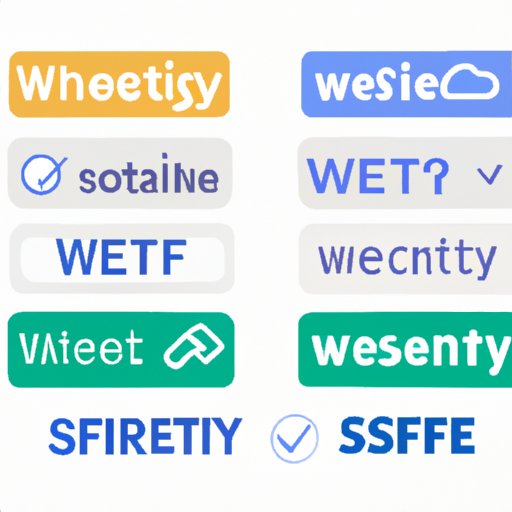
Introduction
As the internet continues to expand, the number of websites available for browsing has grown exponentially. However, not all websites are created equal, and some can be dangerous or malicious. It’s essential to know whether a website is safe and legitimate before interacting with it. This article aims to provide readers with tips and tricks to identify whether a website is legitimate or not.
Research the Website Domain
Researching a website domain is an essential step in determining the website’s legitimacy. A professional-looking domain name typically has a short, straightforward name that reflects what the website is all about. For example, “Amazon.com” is a well-known domain that reflects a reputable online marketplace. In contrast, websites with long, confusing, or irrelevant domain names may raise suspicion.
The following factors can help you determine whether a domain name is suspicious:
- The domain name contains keywords or phrases that are irrelevant to the website’s content.
- The domain name has a strange extension, such as “.biz” or “.xyz.”
- The domain name has numbers or strange characters.
- The website lacks a domain name entirely and uses only an IP address.
Here are some examples of legitimate and suspicious domain names:
- Legitimate: Google.com, Facebook.com, Microsoft.com
- Suspicious: Free-lottery-winners-now.biz, miraclecureforyou.com, princesneedhelp.com
It’s essential to use key tools like Whois or ICANN to check if a domain name is legitimate. These tools allow you to obtain valuable information about the website, such as the domain owner’s name, registration date, and expiration date.
Check for Contact Information
A legitimate website should have easily accessible contact information available to its users. Contact pages should be easy to find on the website, and the information provided should include the website owner’s name, location, email address, and phone number.
To search for the website owner’s contact information, you can use tools such as Whois and ICANN. You can also check the website’s “About” page and “Contacts” section where the website owner may have provided the information.
The following are some features that a legitimate contact page should have:
- The website owner’s name and location are provided.
- An email address and phone number are available, and they work correctly.
- Links to social media accounts are provided.
Here are some examples of legitimate and suspicious contact information:
- Legitimate: support@amazon.com, contact@microsoft.com, hello@buzzfeed.com
- Suspicious: freeipad@scammer.com, noemail@noreply.info, callme@fakephonenumber.com
Look for Security Indicators
When browsing, it’s essential to keep yourself safe by ensuring that the website you’re interacting with has the appropriate security measures in place. The presence of security indicators is one way to determine a website’s safety. The following are some security indicators that determine whether a website is legitimate:
- A padlock icon in the browser address bar or next to the website address.
- “HTTPS” at the beginning of the website URL.
- Trust badges from reputable organizations, such as Norton, Google, or McAfee, among others.
It’s crucial to check for the above indicators before interacting with a website.
Here are some examples of legitimate and suspicious security indicators:
- Legitimate: A padlock icon, HTTPS, and trust badges from reputable organizations.
- Suspicious: No padlock icon, HTTP, and no trust badges.
Check Online Reviews
Reviews from other people can help you determine whether a website is legitimate or not. Positive reviews can indicate a website’s reliability and quality of service, while negative reviews can be an indication of suspicious or malicious activity.
To search for reviews of a website, you can use review websites such as Yelp, Trustpilot, and the Better Business Bureau. However, it’s important to note that not all reviews are genuine and that some websites may even pay for fake reviews to boost their ratings.
Here are some examples of legitimate and suspicious online reviews:
- Legitimate: Positive reviews with a high rating and honest feedback.
- Suspicious: Negative reviews with low ratings and generic feedback. Be wary of reviews that sound too similar or those that use bad grammar or punctuation.
Compare with Other Websites
Comparing similar websites can help you get a better understanding of the website you’re examining and determine whether it’s legitimate or suspicious.
You can search for competing websites that offer similar services or products and compare them with the target website. Comparing the prices, features, and overall website design can help you determine what’s reasonable and what’s not.
Here are some examples of legitimate and suspicious comparisons:
- Legitimate: Websites with similar product or service offerings at comparable prices and comparable website designs.
- Suspicious: Websites with similar content but at an absurdly low price, or with a poor website design compared to other competing websites.
Conclusion
Now that you have learned some tips and tricks on how to identify legitimate websites, you’re better equipped to stay safe while browsing. Remember to research the website domain, check for contact information, look for security indicators, check online reviews, and compare similar websites. It’s essential to be wary of suspicious websites regardless of how tempting their offers may sound.




